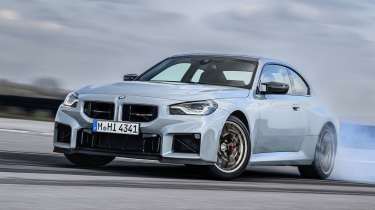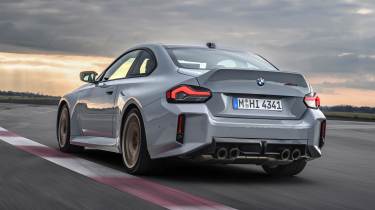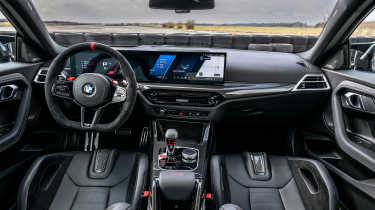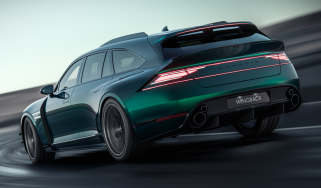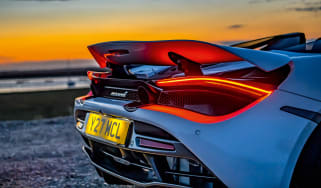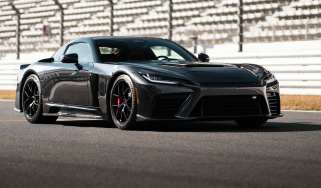BMW M2 CS review – another all-time great M car?
The original M2 CS is one of the best M cars of the modern era, and the first BMW to win evo Car of the Year. Can this new G87 version repeat its success?
Visually, the new M2 CS gives off all the right signals. It tells you what it is before it’s turned a wheel: a muscled up front-engined coupe that’s dripping with attitude, pinched at the waist, wide at the hips and up for a fight. That bit lower, that bit more menacing than a standard M2, with an unapologetic ducktail kicking up vertically at the rear. It looks like it’ll be an absolute riot, an M2 with the aggression dialled right up, and the badge promises much too. Past CS models have been stellar, with carefully targeted tweaks and upgrades to bring out the very best in M cars for road use, without going to extreme CSL levels. The previous M2 CS is a case in point, packing huge character and sense of purpose in a compact package, enough to win evo Car of the Year in 2020. A tough act to follow.
On paper the new car has the goods to deliver. A 3-litre straight-six boosted from 473bhp to 523bhp, for one, but the standard M2 isn’t exactly wanting for power. What it does need is a better sense of connection, particularly through the steering, and perhaps a bit more bite and aggression in its chassis. That’s exactly what the CS makeover is targeted at. It remains rear-drive (unlike the M3/4, which are four-wheel drive only in the UK) and sits 8mm lower on retuned springs and dampers, with reworked steering software, a recalibrated Active M Differential, stiffer engine mounts and optional carbon ceramic brakes among the other changes.
The stability systems have been retuned for track use and BMW’s excellent M Traction Control system makes an appearance, with ten stages of adjustment. Weight saving is on the agenda too, with a new carbon bootlid (with the aforementioned integrated ducktail), a carbon roof and staggered forged wheels trimming the kilos, as well as carbon for the seats and centre console – the latter sans cup holders. The result? A 30kg saving, making this a 1700kg baby M car. Hmm.
More reviews
Group tests
In-depth reviews
- BMW M2 2025 review – a fun, full-fat M car but no match for a Cayman
- F87 BMW M2 (2015-2021) review – a last hurrah for the small rear-drive M-car
Long term tests
Reviews
Twist yourself around the carbon bolsters and you sink low into the CS, the seats fabulously supportive, the wheel reaching out to meet you. But it somehow doesn't feel very compact. Though it's stubbier than an M4 it's just as wide, and it feels like there's a mass of dashboard and fascia around you. The large, thick-rimmed wheel doesn't help you feel intimately plugged into the car either. And then the controversial bit – unlike its predecessor, the CS is only offered with two pedals, with no option of a manual. The standard M2’s manual ‘box wouldn’t be able to deal with the CS’s increased 479lb ft torque output (in the standard car it’s already limited to 406lb ft, to the auto’s 442), so BMW’s eight-speed M Steptronic torque converter it is. In truth this isn’t the loss it might seem to be. The M2’s manual isn't the most satisfying anyway, and with their central leg divider, the carbon bucket seats clearly weren’t designed with three pedals in mind.
Thumb the start button and the straight-six fires into life with a gravelly tone, and even with everything left in Comfort mode there's a feeling of effortless propulsion as soon as you get moving. The engine’s low-down flexibility zaps away any sense of inertia, and then you notice the extra snap and clarity to the steering; it may not be a physically small car but it does a good job of responding like one, and you can drive with calm hands and position it sweetly. BMW pulls a similar trick with the M3 and M4, which always feel keener than physics should allow, but that feeling is more vivid here, the M2 carrying fewer kilos within a shorter wheelbase. It pivots through corners with real positivity as you wind on lock, and soon your attention turns to the rear, and managing the slug of 442lb ft to the 285-section Michelins. With the TC left on the CS reigns itself back if you’re greedy with the throttle, but soon hits a ferocious stride as it chomps through the lower gears. The shifts are quick and clean but lack the crispness of a DCT, but with no pause needed to punch the clutch in and grab a gear manually, it makes for an unrelenting, eye-opening surge. Baby M car? This was M5 pace not too long ago.
Though it’s big on numbers the straight-six isn’t the most special sounding engine, the gruff growl never blooming into something musical, even when you rev it out. But it’s a great partner for the chassis, all that torque and power giving you freedom to work the rear axle at will when you loosen the reins of the TC. Do that and the CS is a bit of a monster. It still finds impressive traction if you’re smooth, but slip is often just a toe-twitch away, particularly when loaded up through a corner with the engine primed in the lower gears. You can point the nose in and induce subtle slides that require barely any correction, neatly overdriving the rears until they regain traction again. The variable TC lets you drive in this sweet spot with minimal intervention, stringing together corner after corner with a fantastic sense of adjustability.
As you build confidence and brake deeper, lean harder on the front end and test the limits of the rear, some elements of the CS don't totally gel. At times the weight makes itself known, the rear end not feeling nailed-on precise under full power over bumps, and the steering doesn’t load up convincingly in your hands to build a clear picture of when the front Michelins are starting to scrub. The latter may be a symptom of the tyres. Our test car was delivered on Pilot Sport 4S’s, but BMW offers more aggressive Cup 2 or Cup 2 R rubber (or their Pirelli equivalents) from factory. Past CS models have been optimised for stickier rubber and we wouldn’t be surprised if the M2 would shine brighter on Cup 2s, not only because of the extra grip but more positive feedback through the steering. It’s ironic given that we’ve struggled with the rear-drive M4 CSL on Cup 2s in the past (albeit in wintry conditions), but on warm dry roads it does feel like stickier rubber would bring the M2 to life, complimenting its newfound precision and attitude, letting you lean on it with more intent.
Still, even on less aggressive rubber the M2 CS is exploitable and every bit as expressive as an M car should be. It takes time to trust it but once you're in tune it's a right laugh, the extra power and precision bringing out more of the M2’s character and letting you explore its balance more of the time, on a wider range of corners. It leaves you with an appetite to drive it more and peel back the layers, because you can corner in pretty much any way you want – cutting precise lines DTM-style, or steering it on the throttle gratuitously, just for the hell of it. It's a really entertaining car, and it'd be better still with a greater sense of connection and feedback to truly immerse you, and close the gap of detachment that otherwise remains. Perhaps a set of Cup 2s would change that. As it stands the CS is a cracking M car, but another world beater? The jury's still out.
Price and rivals
The CS is priced at a very punchy £92,475, or just over £23k more than a base M2. That puts it within range of some pretty serious sports cars, not least BMW’s own M4 Competition from the class above (£91,740). Lotus’s flagship Emira V6 SE is within touching distance at £96,500, although Porsche’s cheapest 911 Carrera is a chunk more expensive at £103,700, so too Alpine’s (brilliant) £106k A110 R.
For an enormous £23k less than the CS there’s the A110 GTS to consider, plus Porsche’s 718 Cayman GTS 4.0 – if you can get your hands on one from dealer stock, now that it’s been discontinued. Less powerful than the M2 but more specialised and nuanced in how they tackle a road, we’d be very tempted by one of these mid-engined alternatives, particularly as neither will be around for much longer.

